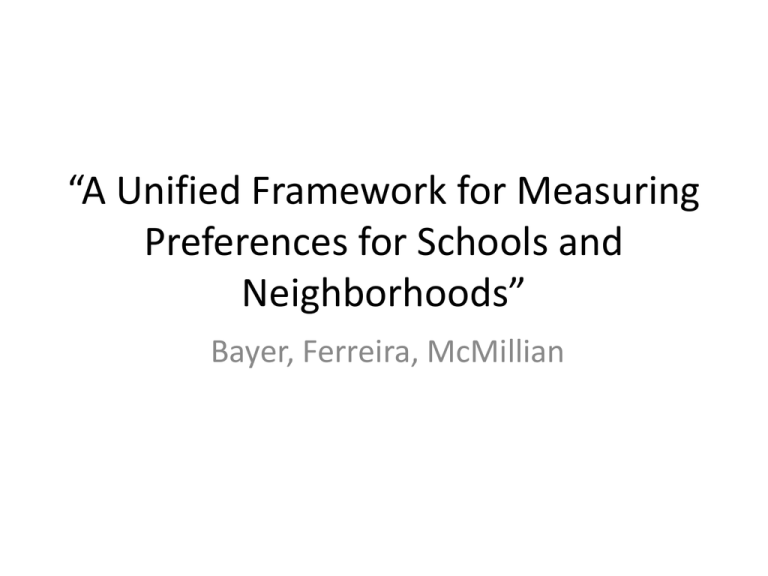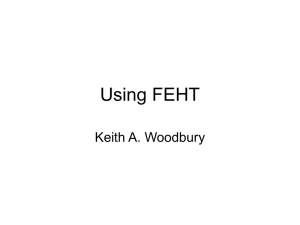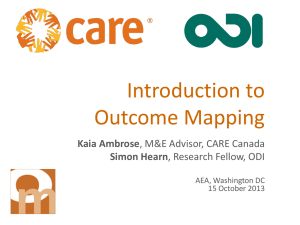X h
advertisement

“A Unified Framework for Measuring Preferences for Schools and Neighborhoods” Bayer, Ferreira, McMillian Research Question • How to measure households value for good schools and neighborhood characteristics? • Why do we care? – School quality affects economically important outcome like earnings (important topic in labor economics) – Public policy: property taxes fund education, policy evaluation e.g. cost benefit analysis of desegregation programs Literature Review • Black (QJE, 1999) -Typical approach look at effect of school quality on test scores and earnings -Alternative approach: estimate households willingness to pay for better school • Basic idea: when agent purchases a home, she is also pay for: – Type of house she buys – the schools that her children go to – Neighborhood characteristics Willingness to Pay • Hedonic Model: – X- characteristics of house e.g. size, type, # rooms – Z- neighborhood socio-demographics – ε – error term • ID problem: endogeneity of neighborhood characteristics • Solution: Boundary Discontinuity Design – Instrument for socio-demographics Boundary Discontinuity Design: Ideal Experiment School Attendance Zone A School Attendance Zone B Boundary Discontinuity Design • Socio-demographics of neighborhoods the same • Difference in Quality of school depending on school attendance zone paying for school quality • In practice, need to consider housed in narrow bands (0.1-0.3 miles) – Statistical Power to make inferences • Need to control for socio-demographics Ownership and # of Rooms Test Scores and Housing Prices Contributions • Addresses endogeneity of neighborhood characteristics – Produced more consistent estimates of willingness to pay for good school • Limitation of Study – Does not control for socio-demographics above on beyond boundary instrument Bayer, Ferreira, McMillian – Improve on Black by • Using richer data set – Unrestricted Census Data » Contains block level information • Embedding Boundary Discontinuity Design within discrete choice heterogeneous sorting model Data • Decennial Census -- restricted version (1990) – Filled out by 15% of households – Individual Level Data: race, age, education attainment, income of each household member, type of residence: owned, rented, property tax payment, number of rooms, number of bedroom, types of structure, age of building, house location, workplace location – Neighborhood level data: race, education, income composition, also add data on crime, land use, topography, local schools – matched with county level transactions data, matched with HMDA data • • Relevant Study Sites: Area: Bay Area: Alameda, Contr Costa, Marin, San Mateo, San Francisco, Santa Clara • Advantages: – – • to get 60% of home sales and neighborhood variables for 85% small area, ppl don’t typically commute out of area lots of data: » 1,100 census tracts, 4,000 census block groups, 39500 census » full sample 650k people, 242.1k households School quality measure: avg. 4th grade math and reading score – Advantage: easily observable to both teachers and parents Summary Statistics • • • • • • Home value $300,000 Rent $750/month, 60% homes owned, 68% black, 8% white, 44% head of households college degree, avg. block income $55,000 Implementing BDD • Each census block assigned to closest school attendance zone boundary • Each block paired with a “twin” census block – Closest block on opposite side of boundary • For each pair, block with lowest average test score designated “low” side of boundary, the other “high” side • Boundary Cutoff: census blocks ≤ 0.2 miles from nearest (SAZ) – Have power to restrict even further to ≤ 0.1 m BBD Continuous Observations • Housing Characteristics that are continuous across the boundary: – Number of rooms – Construction date – Ownership status: owner occupied/rented – Size: lot size, square footage Construction Date and Size BBD Discontinuous Observations • Housing Characteristics that are discontinuous across the boundary: – House Price (by $18,719 , i.e. 7%-8% of mean value) • Neighborhood Characteristics that are discontinuous across the boundary: – – – – Test Scores (by 74 pts) Percentage Black (by 3%) Percentage with College Degree (by 5%) Mean Income (by $2,861, i.e.6%-7%) Education, Income & Race Conceptual Take Away – Quality of physical housing stock same across boundary – prices different – socio-demographics – and test scores different – Inference: households on the “high” side of the boundary paying for higher quality schools and sorting into the SAZ with better schools Hedonic Price Regression Comments • Accounting for Boundary Fixed Effects Reduces hedonic valuation of good schools – Consistent with Black (1999) • Controlling for Neighborhood Sociodemographics reduces it further • Households racial preferences for neighbors not capitalized in housing prices – Coefficient on percent black drops from -$100 to almost zero with Boundary fixed effects Robustness Checks • School level socio-demographics – Race, language ability, teacher education, student income – estimate on preference for school test score in baseline: 17.3 (5.9) – with addition control estimate: 22.6 (8.5) • Inclusion of Block-level socio-demographics • Dropped Top Coded Houses in Census Data (with values greater than $500,000) • Use housing prices from transactions data • Using Only owner occupied units • Take-away: results robust to those in base-line specification w/o these detailed measures Discrete Choice Sorting Model • Model – Each household (i) decides which house (h) to buy/rent – Random Utility Model (McFadden) • House characteristics (Xh) – size, age, type) – Type (owned/rented) – Neighborhood and School characteristics • • • • • Distance from house to work (d ih) Boundary fixed effects (Θbh) Price (ph) Unobserved housing quality (ξh) Individual specific error term (εih) Maximization Problem • Objective: • Allow for agents valuation of housing characteristics to depend on individual characteristics: Estimation Strategy • Two step process – Separate utility function into part that captures mean preferences and part that captures preference heterogeneity – Step #1: Use MLE to estimate heterogeneous parameters and mean utility – Step #2: Separate mean utility in components that are observable and unobservable • Utilize assumption that Individual specific error term (εih) follows extreme value distribution • Use characteristics of houses > 3miles away as price instrument to obtain causal estimates Results Comments • Preferences for better schools similar across hedonic BDD estimates and discrete choice model • Preferences for black neighbors highly negative in discrete choice model estimate – Different from hedonic estimation for race preference – Idea: self-segregation by race can arise through sorting that does not affect equilibrium prices Robustness Checks








